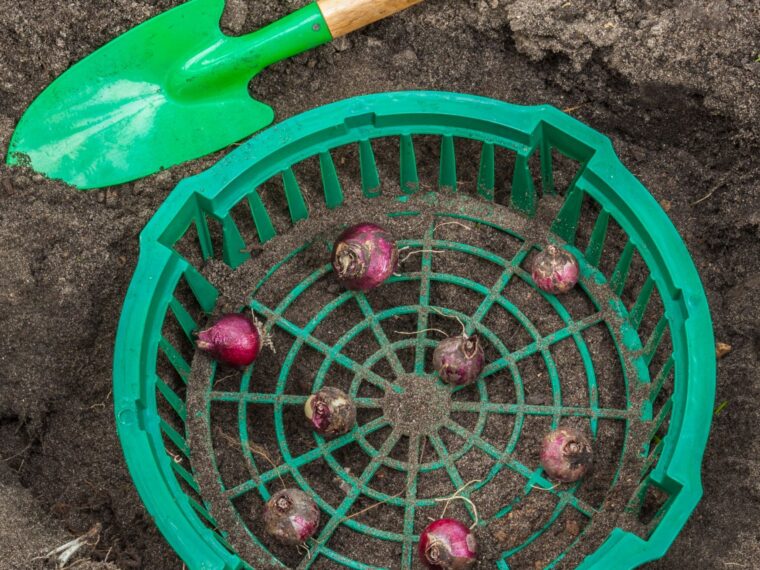4. Hori Hori Knife
The Hori Hori knife is a versatile gardening tool that can be used for everything from cutting through roots to digging planting holes. With its sharp blade and depth markings, it can cut through tough soil and be used to measure the proper planting depth for bulbs.
Why it’s great: Multipurpose and compact, great for precise planting in tighter spaces or around other plants.
5. Bulb Planting Basket
If you’re tired of squirrels digging up your bulbs, or you simply want to be able to easily lift and divide bulbs in the future, a bulb planting basket is a great investment. It’s a mesh container that you place in the ground, fill with bulbs, and then bury. The basket protects the bulbs from pests and makes it easy to lift them out when you need to move or divide them.
Why it’s great: Protects bulbs from being eaten by pests and makes future maintenance easier.
6. Garden Dibber
A garden dibber is a small, pointed tool that can be used to poke holes in the ground for small bulbs like crocuses or snowdrops. It’s quick and efficient, particularly if you’re planting in soft soil or a raised bed.
Why it’s great: A simple, efficient tool for small bulbs and easy soil conditions.
7. Kneeling Pad or Garden Kneeler with Handles
While this isn’t directly a planting tool, any gardener who’s spent time kneeling in the dirt knows the importance of comfort. A soft kneeling pad or a garden kneeler with handles allows you to comfortably get close to the ground without straining your knees or back. Some garden kneelers even double as small benches, giving you a break from bending and stooping.
Why it’s great: Increases comfort during long planting sessions, reducing fatigue.
Bulb Planting Tips for Success
With the right tools in hand, bulb planting becomes an enjoyable and rewarding process. Here are a few final tips to ensure your bulbs thrive:
- Choose the Right Location: Most spring bulbs need full to partial sunlight to grow well. Ensure you plant them in a spot that gets enough light throughout the day.
- Check Your Soil: Well-draining soil is essential for healthy bulbs. If your soil tends to retain water, consider adding some sand or compost to improve drainage.
- Plant at the Right Depth: Different bulbs need to be planted at different depths. As a rule of thumb, plant bulbs at a depth that is two to three times the height of the bulb itself.
- Space Them Out: Don’t overcrowd your bulbs. Give each one enough space to grow without competing with its neighbors for nutrients.
- Mark Your Bulb Beds: After planting, mark the spots where your bulbs are located, so you don’t accidentally disturb them when planting other plants in the spring.
Conclusion
Fall is the perfect time to plant spring-blooming bulbs, and with the right tools, the process can be quick and efficient. Save your money by skipping unnecessary bulb fertilizers, and instead, focus on using tools like bulb augers and planters to make the job easier. Whether you’re planting a few dozen bulbs or several hundred, these seven tools will help you get the job done faster and with less effort, all while ensuring your bulbs have the best chance to thrive come spring. Happy planting!
